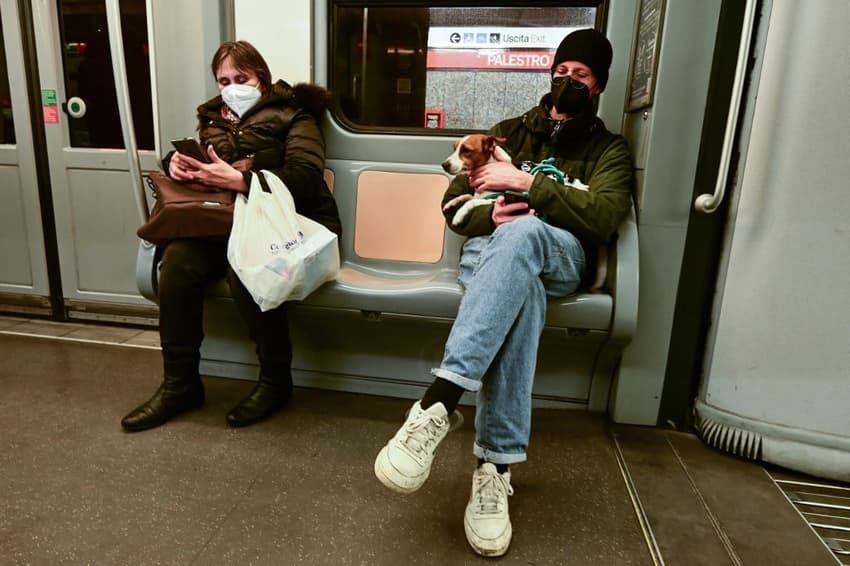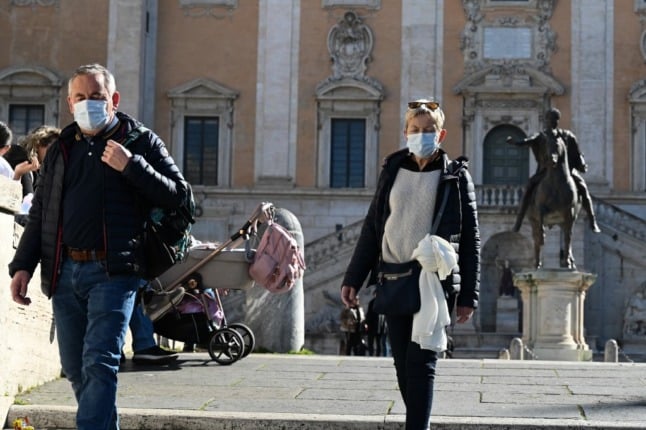EXPLAINED: Why is Italy’s coronavirus infection rate rising again?

After Italian health ministry data showed Covid cases are on the increase for the first time in weeks, why is this happening and is it likely to continue? Here's what Italy's health experts say.
The number of Covid cases detected in Italy has been falling for the last five weeks. But it began to rise again in early March, according to the latest data published by the Higher Health Institute (ISS) and the health ministry on Friday.
"During this week there was an inversion in the trend of the Covid-19 curve in Italy,” confirmed ISS President Silvio Brusaferro as he presented the data at a press conference.
"In recent weeks it has been decreasing. Last week the decrease slowed down, and this week we are witnessing a curve that begins to rise again".
The increase came despite the fact Italy has strict health measures in place including the requirement to show proof of vaccination or recovery under 'super green pass' rules, and a mask mandate for all indoor and some outdoor public places.
In the last two weeks, the incidence of Covid infections in around half of all Italian provinces has stalled or risen, health ministry data showed.
The number of known current positive cases is once more nearing a million, and the weekly incidence rate has risen to 510 cases per 100,000 people, up from 433 the previous week.
On Monday, official data showed new cases were up by 30 percent week-on-week, while the test positivity rate is 14.1 percent..
Giovanni Rezza, the health ministry's director of prevention, confirmed that hospitalisation rates are still decreasing for now.
"Regarding the occupancy rate in the hospital wards and intensive care, we are at 12.9 percent and 5.5 respectively,” he said at Friday’s press conference.

People wearing face masks at the Capitoline Hill in Rome. The Italian government eased the requirement to wear masks outdoors after a decline in the number of Covid-19 cases in February, but the rule still applies in some settings. Photo by Vincenzo PINTO / AFP
Though Italy’s health experts are urging people to remain cautious, they stress that it is too early to know whether the situation is likely to worsen further.
“There is no reason for us to be alarmed ahead of time", immunologist Sergio Abrignani, a member of the government’s scientific advisory board, told newspaper Corriere della Sera on Monday.
The increase in cases is due to "a series of factors”, he said, “and it is not guaranteed that it will persist.”
Nino Cartabellotta, president of Italy’s evidence-based medicine foundation Gimbe, said it would take “7-10 days” to see whether this is truly a reversed trend or “just a rebound”.
“We now have a fairly high circulation of the virus. We still have a million positives and 40,000 cases per day,” he cautioned in an interview with Radio Cusano Campus. “There is no doubt about this. But the element of concern is that the descent has stopped and there are also hints of an ascent".
Experts attributed the rise to several factors, including colder weather, and decreased caution as people look ahead to the planned end of certain health measures in Italy.
Decreasing vaccination rates are also thought to be a major factor, as well as new "sub-variants" of coronavirus, Brusaferro noted at the press conference.
“Omicron sub-variants, such as 2, the most transmissible, are growing," he said.
Cartabellotta also said the rise may be due to “the sub-variant Omicron 2 , of which we know nothing” as well as the recent spate of very cold weather meaning “we are more indoors where the virus spreads more”.
He said the rise was also connected to public behaviour, with Italy now looking ahead to a promised relaxation of the health measures - even though the government is yet to confirm details of the plan.
Italy eased some measures in early February, including the requirement to wear a mask in all outdoor public places.
"In Italy the increase in Covid cases is linked to a series of factors, including a certain relaxation on the part of the population, coinciding with the end of the state of emergency - which has been sold, even though it is a deadline of a purely regulatory nature, as a sort of watershed”.
Italian Prime Minister Mario Draghi confirmed in late February that the country’s state of emergency - the condition that allows the government to pass emergency laws by decree - will end on March 31st, after more than two years.
This doesn’t automatically mean the end of health measures in Italy. However, Draghi also confirmed that 'super green pass' rules would be lifted “gradually” from April.
The government is expected to give further details of plans for easing the rules on Thursday, March 17th.
Comments (1)
See Also
The number of Covid cases detected in Italy has been falling for the last five weeks. But it began to rise again in early March, according to the latest data published by the Higher Health Institute (ISS) and the health ministry on Friday.
"During this week there was an inversion in the trend of the Covid-19 curve in Italy,” confirmed ISS President Silvio Brusaferro as he presented the data at a press conference.
"In recent weeks it has been decreasing. Last week the decrease slowed down, and this week we are witnessing a curve that begins to rise again".
The increase came despite the fact Italy has strict health measures in place including the requirement to show proof of vaccination or recovery under 'super green pass' rules, and a mask mandate for all indoor and some outdoor public places.
In the last two weeks, the incidence of Covid infections in around half of all Italian provinces has stalled or risen, health ministry data showed.
The number of known current positive cases is once more nearing a million, and the weekly incidence rate has risen to 510 cases per 100,000 people, up from 433 the previous week.
On Monday, official data showed new cases were up by 30 percent week-on-week, while the test positivity rate is 14.1 percent..
Giovanni Rezza, the health ministry's director of prevention, confirmed that hospitalisation rates are still decreasing for now.
"Regarding the occupancy rate in the hospital wards and intensive care, we are at 12.9 percent and 5.5 respectively,” he said at Friday’s press conference.

Though Italy’s health experts are urging people to remain cautious, they stress that it is too early to know whether the situation is likely to worsen further.
“There is no reason for us to be alarmed ahead of time", immunologist Sergio Abrignani, a member of the government’s scientific advisory board, told newspaper Corriere della Sera on Monday.
The increase in cases is due to "a series of factors”, he said, “and it is not guaranteed that it will persist.”
Nino Cartabellotta, president of Italy’s evidence-based medicine foundation Gimbe, said it would take “7-10 days” to see whether this is truly a reversed trend or “just a rebound”.
“We now have a fairly high circulation of the virus. We still have a million positives and 40,000 cases per day,” he cautioned in an interview with Radio Cusano Campus. “There is no doubt about this. But the element of concern is that the descent has stopped and there are also hints of an ascent".
Experts attributed the rise to several factors, including colder weather, and decreased caution as people look ahead to the planned end of certain health measures in Italy.
Decreasing vaccination rates are also thought to be a major factor, as well as new "sub-variants" of coronavirus, Brusaferro noted at the press conference.
“Omicron sub-variants, such as 2, the most transmissible, are growing," he said.
Cartabellotta also said the rise may be due to “the sub-variant Omicron 2 , of which we know nothing” as well as the recent spate of very cold weather meaning “we are more indoors where the virus spreads more”.
He said the rise was also connected to public behaviour, with Italy now looking ahead to a promised relaxation of the health measures - even though the government is yet to confirm details of the plan.
Italy eased some measures in early February, including the requirement to wear a mask in all outdoor public places.
"In Italy the increase in Covid cases is linked to a series of factors, including a certain relaxation on the part of the population, coinciding with the end of the state of emergency - which has been sold, even though it is a deadline of a purely regulatory nature, as a sort of watershed”.
Italian Prime Minister Mario Draghi confirmed in late February that the country’s state of emergency - the condition that allows the government to pass emergency laws by decree - will end on March 31st, after more than two years.
This doesn’t automatically mean the end of health measures in Italy. However, Draghi also confirmed that 'super green pass' rules would be lifted “gradually” from April.
The government is expected to give further details of plans for easing the rules on Thursday, March 17th.
Join the conversation in our comments section below. Share your own views and experience and if you have a question or suggestion for our journalists then email us at [email protected].
Please keep comments civil, constructive and on topic – and make sure to read our terms of use before getting involved.
Please log in here to leave a comment.